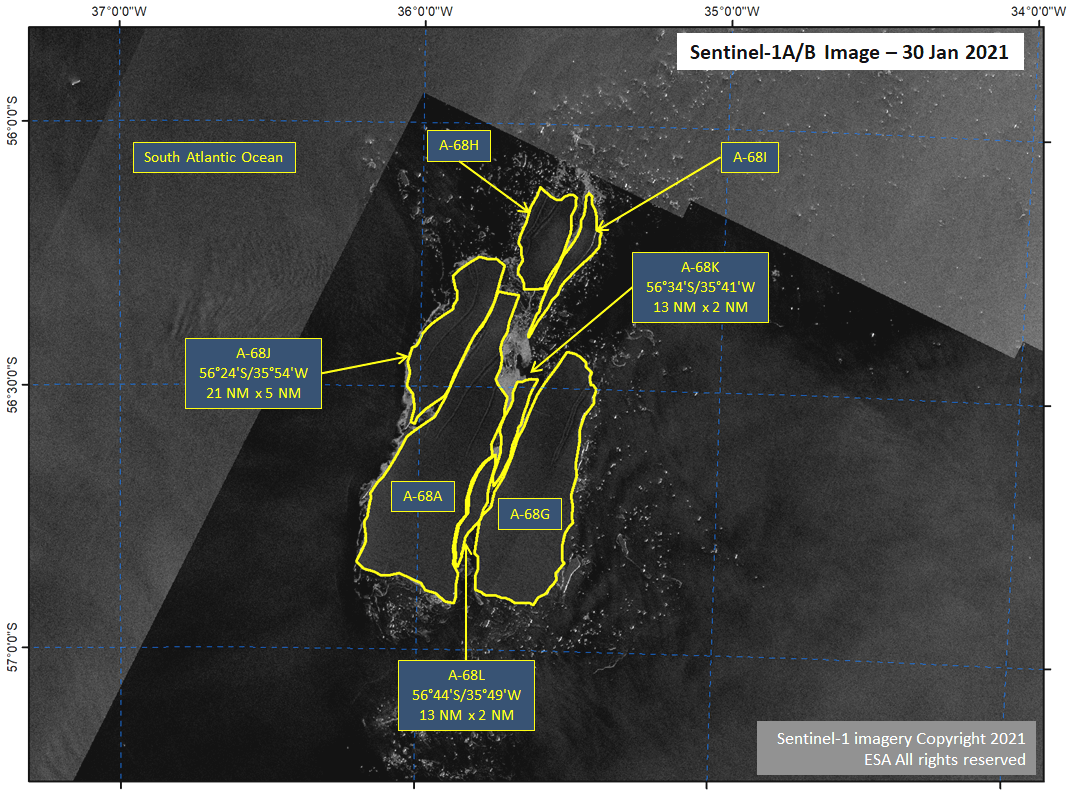Icebergs A-68J, A-68K, and A-68L Calve from Iceberg A-68A in the South Atlantic Ocean
By LT Falon M. Essary, USN
NIC.PAO@noaa.gov
U.S. National Ice Center
January 30, 2021
Suitland, MD — The U.S. National Ice Center (USNIC) has confirmed three new icebergs calved from A-68A in the South Atlantic Ocean. For the third consecutive day, large icebergs have calved from the main iceberg, A-68A as it quickly falls apart near South Georgia Island. As the newly named icebergs A-68G, A-68H, and A-68I drifted away yesterday the three new large icebergs calved. The new iceberg A-68J is located at 56° 24' South, 35° 54' West and measures 21 nautical miles on its longest axis and 5 nautical miles on its widest axis. The new iceberg A-68K is located at 56° 34' South, 35° 41' West and measures 13 nautical miles on its longest axis and 2 nautical miles on its widest axis. The new iceberg A-68L is located at 56° 44' South, 35° 49' West and measures 13 nautical miles on its longest axis and 2 nautical miles on its widest axis.
A-68J, A-68K and A-68L were spotted and confirmed by USNIC Ice Analyst Christopher Readinger using the Sentinel-1A/B images shown below.
Iceberg names are derived from the Antarctic quadrant in which they were originally sighted. The quadrants are divided counter-clockwise in the following manner:
A = 0-90W (Bellingshausen/Weddell Sea)
B = 90W-180 (Amundsen/Eastern Ross Sea)
C = 180-90E (Western Ross Sea/Wilkesland)
D = 90E-0 (Amery/Eastern Weddell Sea)
When first sighted, an iceberg’s point of origin is documented by the USNIC. The letter of the quadrant, along with a sequential number, is assigned to the iceberg. For example, C-19 is sequentially the 19th iceberg tracked by the USNIC in Antarctica between 180-90E (Quadrant C). Icebergs with letter suffixes have calved from already named icebergs, where the letters are added in sequential order. For example, C-19D, is the 4th iceberg to calve off the original C-19 iceberg.
The National Ice Center is a tri-agency operational center represented by the United States Navy (Department of Defense), the National Oceanic and Atmospheric Administration (Department of Commerce), and the United States Coast Guard (Department of Homeland Security). The National Ice Center mission is to provide the highest quality strategic and tactical ice services tailored to meet the operational requirements of U.S. national interests and to provide specialized meteorological and oceanographic services to United States government agencies.

For more information, please contact:
National Ice Center
Command Duty Officer
Voice: (301) 943-6977
E-mail: nic.cdo@noaa.gov
Twitter: @usnatice
Facebook: @usnatice
The U.S. National Ice Center is a tri-agency center operated by the Navy, NOAA, and Coast Guard and provides global to tactical scale ice and snow products, ice forecasting, and related environmental intelligence services for the United States government.